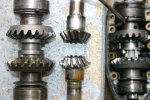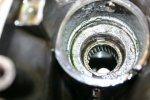58CorrySuburban
Seaman
- Joined
- Sep 28, 2008
- Messages
- 73
Hello Again,
So, I took my gear case apart and replaced the pinion gear. The teeth were completely ground down except for the top 1/16th of an inch. There were plenty of metal shavings in the lower gear case cap and gears in general.
I brought the cap, prop shaft and all the parts that slide onto it, to the sink and washed them with soap and water. When I was done there were no more shavings (on the parts I just mentioned). I lubed up the gears/barrings, and reassembled with new seals and gaskets (as per Selco manual).
I just took it out for a drive (2-3 hrs) and drained the oil to make sure it was still there and the right color. It was, but I noticed (in the sun) that the oil looked like metalic paint, having metal dust. There were some larger shavings the size of 1/2 a grain of rice but flat of course (abstract comparison but it works).
I have refilled the gear oil and filtered through a t-shirt 2-3 times and continue to get shavings (though less and less).
The question part of this thesis:
1.) Do you think that the shavings I'm getting are from the old pinion gear, and would there be enough of the system that I didn't sanitize (from the pinion gear and up) to produce residule shavings after I had run the motor?
Or-
Is there a possability that the pinion gear was warn down for some other, unresolved, reason and the shavings are from my last outing/new pinion gear?
2.) How large and how plentiful should the shavings be? (I have a 1958 Evinrude Big twin 35 hp which doesn't have magnetic plugs).
3.) Can I flush the system out with soapy water, then flush with only water then flush with gear oil? (I know it seems easier to just take the gear case back apart but I'm new to this so its not so easy for me and I don't want to mess it because it doesn't leak, everything turns smooth and its finaly back together).
Thanks again in advance for everyone's input. I know my posts are longer than most but I don't want to leave anything out, and if its too much info I try to make it easy by using bold print.
-Josh
So, I took my gear case apart and replaced the pinion gear. The teeth were completely ground down except for the top 1/16th of an inch. There were plenty of metal shavings in the lower gear case cap and gears in general.
I brought the cap, prop shaft and all the parts that slide onto it, to the sink and washed them with soap and water. When I was done there were no more shavings (on the parts I just mentioned). I lubed up the gears/barrings, and reassembled with new seals and gaskets (as per Selco manual).
I just took it out for a drive (2-3 hrs) and drained the oil to make sure it was still there and the right color. It was, but I noticed (in the sun) that the oil looked like metalic paint, having metal dust. There were some larger shavings the size of 1/2 a grain of rice but flat of course (abstract comparison but it works).
I have refilled the gear oil and filtered through a t-shirt 2-3 times and continue to get shavings (though less and less).
The question part of this thesis:
1.) Do you think that the shavings I'm getting are from the old pinion gear, and would there be enough of the system that I didn't sanitize (from the pinion gear and up) to produce residule shavings after I had run the motor?
Or-
Is there a possability that the pinion gear was warn down for some other, unresolved, reason and the shavings are from my last outing/new pinion gear?
2.) How large and how plentiful should the shavings be? (I have a 1958 Evinrude Big twin 35 hp which doesn't have magnetic plugs).
3.) Can I flush the system out with soapy water, then flush with only water then flush with gear oil? (I know it seems easier to just take the gear case back apart but I'm new to this so its not so easy for me and I don't want to mess it because it doesn't leak, everything turns smooth and its finaly back together).
Thanks again in advance for everyone's input. I know my posts are longer than most but I don't want to leave anything out, and if its too much info I try to make it easy by using bold print.
-Josh






















